Submitted by WA Contents
Swiss Pavilion will focuse on the historical absence of female architects at Venice Biennale
Switzerland Architecture News - Apr 22, 2025 - 04:17 6197 views
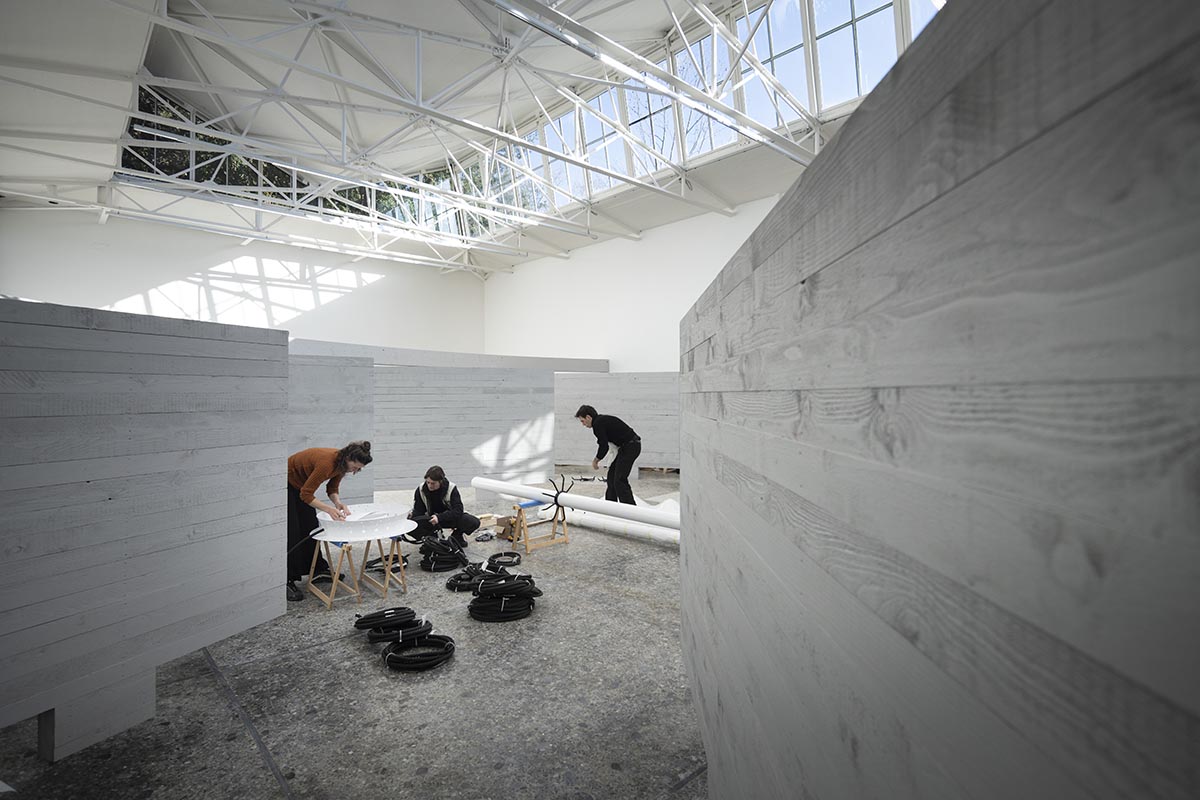
The exhibition "Endgültige Form wird von der Architektin am Bau bestimmt" (The final form will be defined by the architect on site) will be on display in the Swiss Pavilion at the 19th International Architecture Exhibition at the 2025 Venice Architecture Biennale, which was organized by the Swiss Arts Council Pro Helvetia.
Curated by a group of female architects, Myriam Uzor, Amy Perkins, Axelle Stiefel, Elena Chiavi, and Kathrin Füglister, the curators pose the question of "What if the Swiss Pavilion had been designed by Lisbeth Sachs instead of Bruno Giacometti?".
Lisbeth Sachs was one of the first registered women architects in Switzerland and a contemporary of Bruno Giacometti, the designer of the Swiss Pavilion in the Giardini of Venice Architecture Biennale.

Pavilion of Switzerland at the 19th International Architecture Exhibition - La Biennale di Venezia. Construction site of the exhibition "Endgültige Form wird von der Architektin am Bau bestimmt" curated by Elena Chiavi, Kathrin Füglister, Amy Perkins, Axelle Stiefel and Myriam Uzor. Image © Keystone/Gaëtan Bally
In an act of construction that highlights the historical lack of female architects in the Giardini and evokes the spatial memory of lesser-known architectures, the curators hope to revitalize the short-lived art hall designed by Lisbeth Sachs for the 1958 Swiss exhibition for women's work (Saffa) in Zurich at this pavilion.
"What if it were otherwise? — We approach this question as a productive fiction. Juxtaposing Sachs’ work with Giacometti’s brings two architectural visions into coexistence, encouraging visitors to reflect on the need for inclusivity in architectural history and today's practices," said the curators.
"This intervention is not just physical but also temporal, connecting architectural legacies while engaging the visitor’s perceptions of continuity," they added.
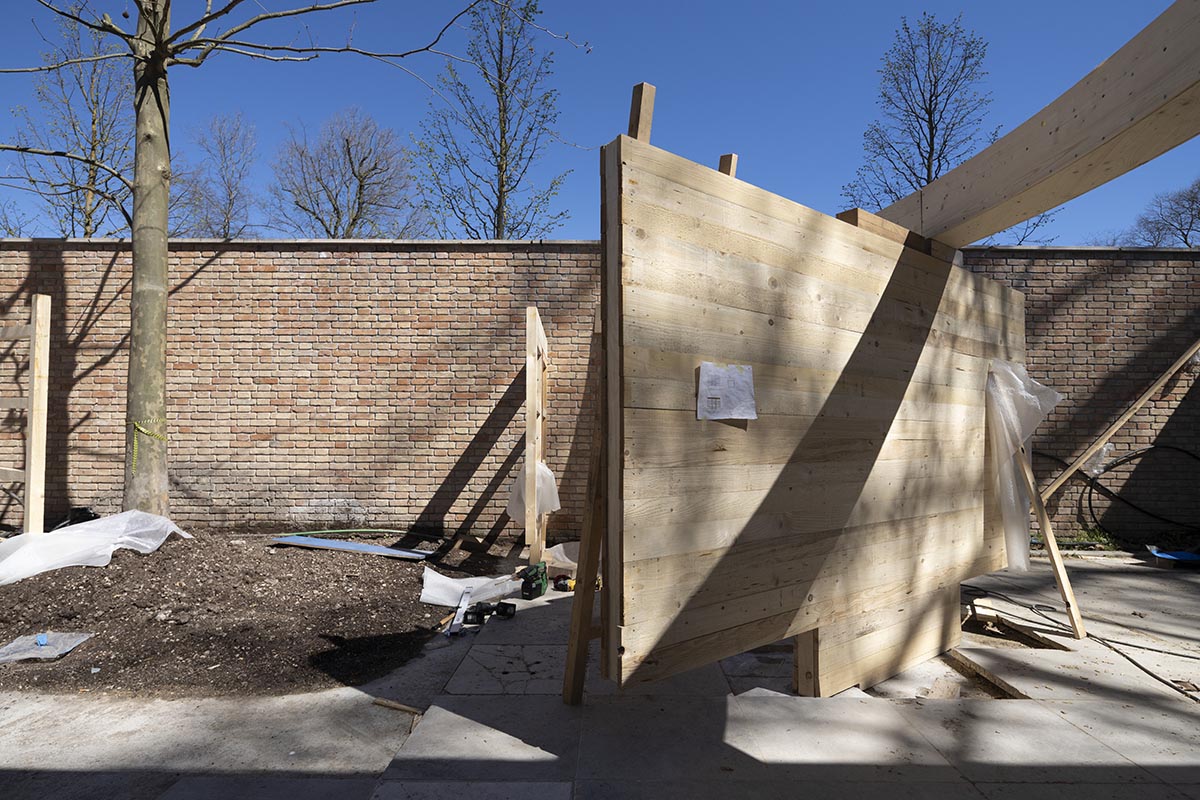
Pavilion of Switzerland at the 19th International Architecture Exhibition - La Biennale di Venezia. Construction site of the exhibition "Endgültige Form wird von der Architektin am Bau bestimmt" curated by Elena Chiavi, Kathrin Füglister, Amy Perkins, Axelle Stiefel and Myriam Uzor. Image © Keystone/Gaëtan Bally
Lisbeth Sachs’ approach to architecture
Lisbeth Sachs approached architecture with inclusivity and respect, utilizing not only labor and material resources but also natural resources. Her 1958 design for the Kunsthalle at the Saffa in Zurich is an example of how she was able to create environments that encouraged participation.
The exhibition "Endgültige Form wird von der Architektin am Bau bestimmt" was highly influenced by this project, which is a rare example of architecture—an inclusive and innovative approach, even for its time.
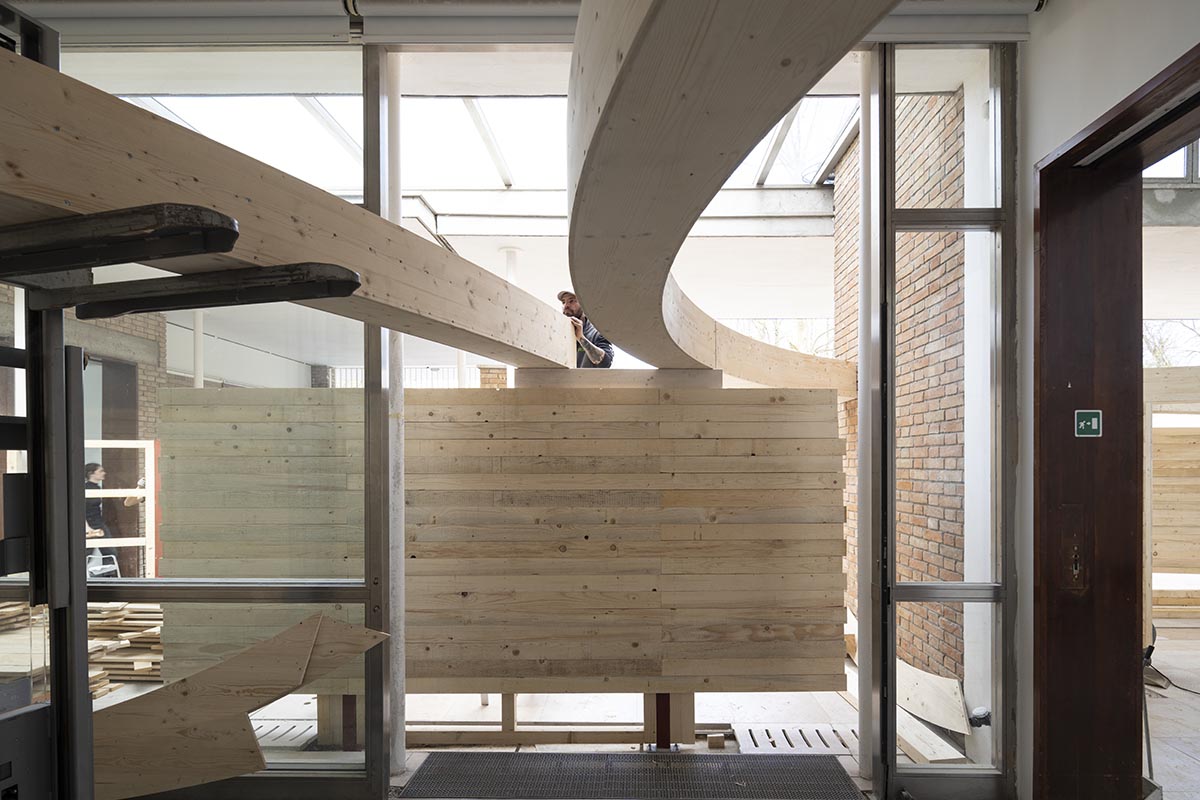
Pavilion of Switzerland at the 19th International Architecture Exhibition - La Biennale di Venezia. Construction site of the exhibition "Endgültige Form wird von der Architektin am Bau bestimmt" curated by Elena Chiavi, Kathrin Füglister, Amy Perkins, Axelle Stiefel and Myriam Uzor. Image © Keystone/Gaëtan Bally
The curators carry this vision in their design for the Swiss Pavilion, creating something entirely new, yet deeply rooted in its spirit: "During our research, one detail that truly stood out was a drawing in which Sachs wrote: "Endgültige Form wird von der Architektin am Bau bestimmt (The final form will be defined by the architect on site.)"
"This sentence resonated with us so strongly that it became our project’s title. Lisbeth Sachs explicitly identified herself as a female architect as early as the 1950s—something that strikes us as extraordinary act in our profession. It was a statement of strong independence, which we felt compelled to embrace and make our own," the curators added.
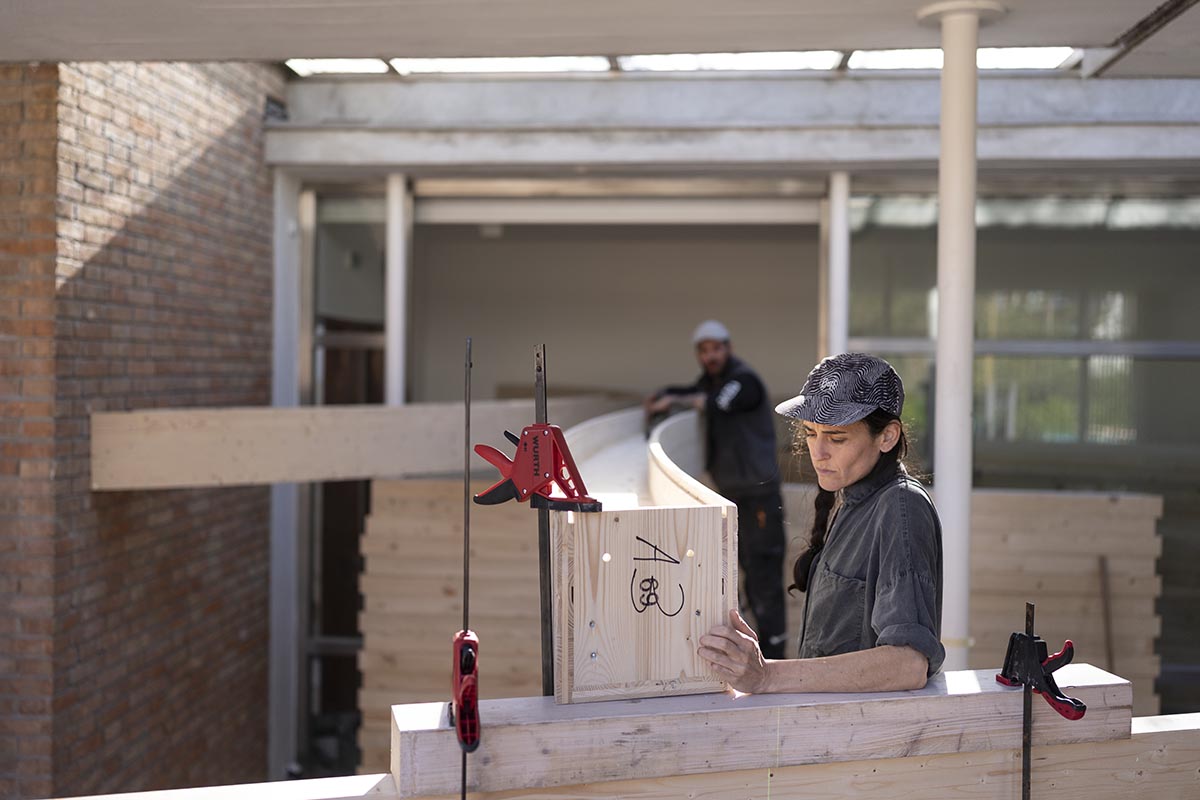
Pavilion of Switzerland at the 19th International Architecture Exhibition - La Biennale di Venezia. Curator Elena Chiavi at the construction site of the exhibition "Endgültige Form wird von der Architektin am Bau bestimmt." Image © Keystone/Gaëtan Bally
Resounding architecture
The curators examine how Sachs' idea might have impacted the current Swiss Pavilion's design in the show. They use Sachs' method to produce a disjointed, immersive spatial memory that speaks to their own ethical and aesthetic issues as well as those of her time.
A structural and symbolic dialogue is facilitated by the fragmentary reinterpretation of Sachs' pavilion: concrete is transformed into wood, and the centralized lighting system, as it was originally intended, becomes an acoustic medium of transmission—not only between architectural and artistic concepts but also between Sachs' generation and today.
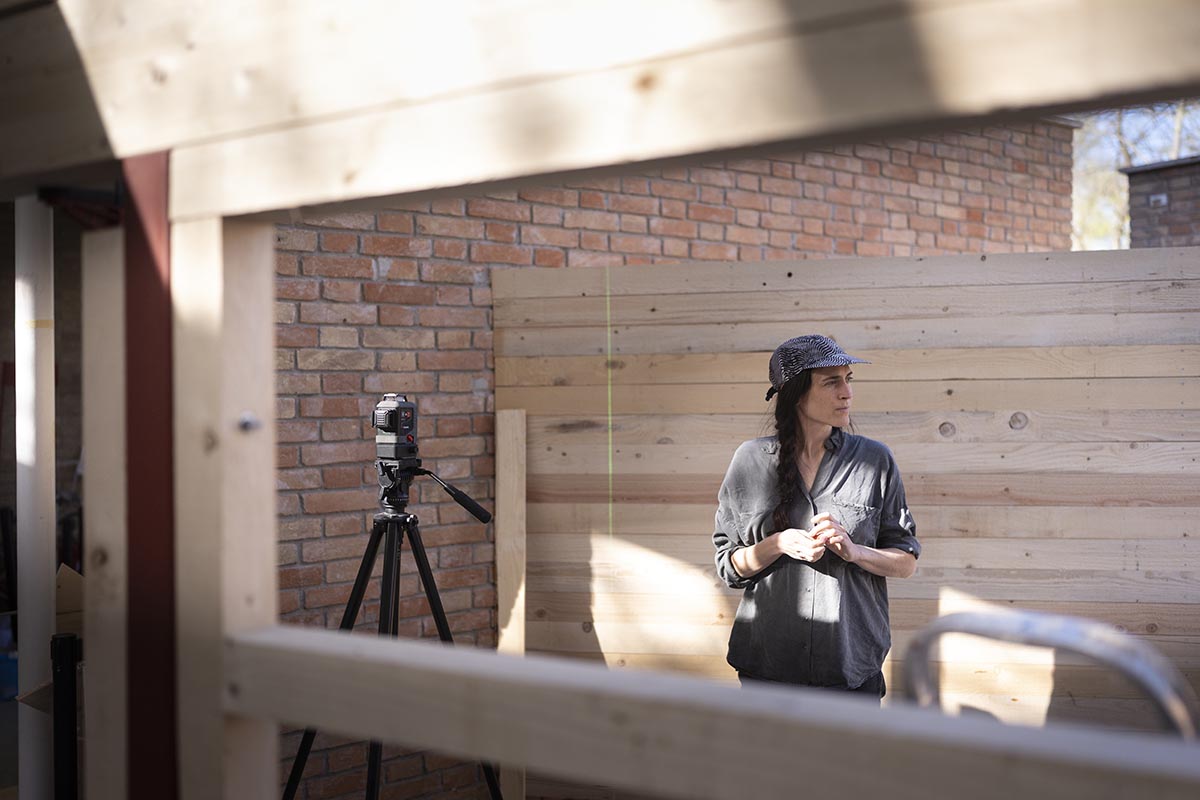
Pavilion of Switzerland at the 19th International Architecture Exhibition - La Biennale di Venezia. Curator Elena Chiavi at the construction site of the exhibition "Endgültige Form wird von der Architektin am Bau bestimmt." Image © Keystone/Gaëtan Bally
The curators turn the pavilion into a multi-sensory experience by incorporating a site-specific sound installation. The curators encourage visitors to experience the unrestricted process of a "resounding architecture" that arises when past and present voices combine by re-creating parts of Sachs' radial floor design and equipping it with a sound system. In a continuous process of tuning, the Kunsthalle tips into another realm as light is transformed into sound.
"We want to create a space that stimulates visitors' imagination, leaving traces of our process without providing definitive answers. For us, it is essential to reintegrate voices that have been forgotten into the broader discourse. The architecture of the future, in our view, must be open, experiential, and inclusive—encouraging visitors to think and imagine," the curators said.
"This is what we hope to convey through our work. Rather than offering a specific answer, we aim to leave a memorable trace that reflects our open-ended process. This approach allows us to contemplate how we live and build today, how we perceive ourselves as individuals and communities, and what our responsibility is in shaping architecture in the present."
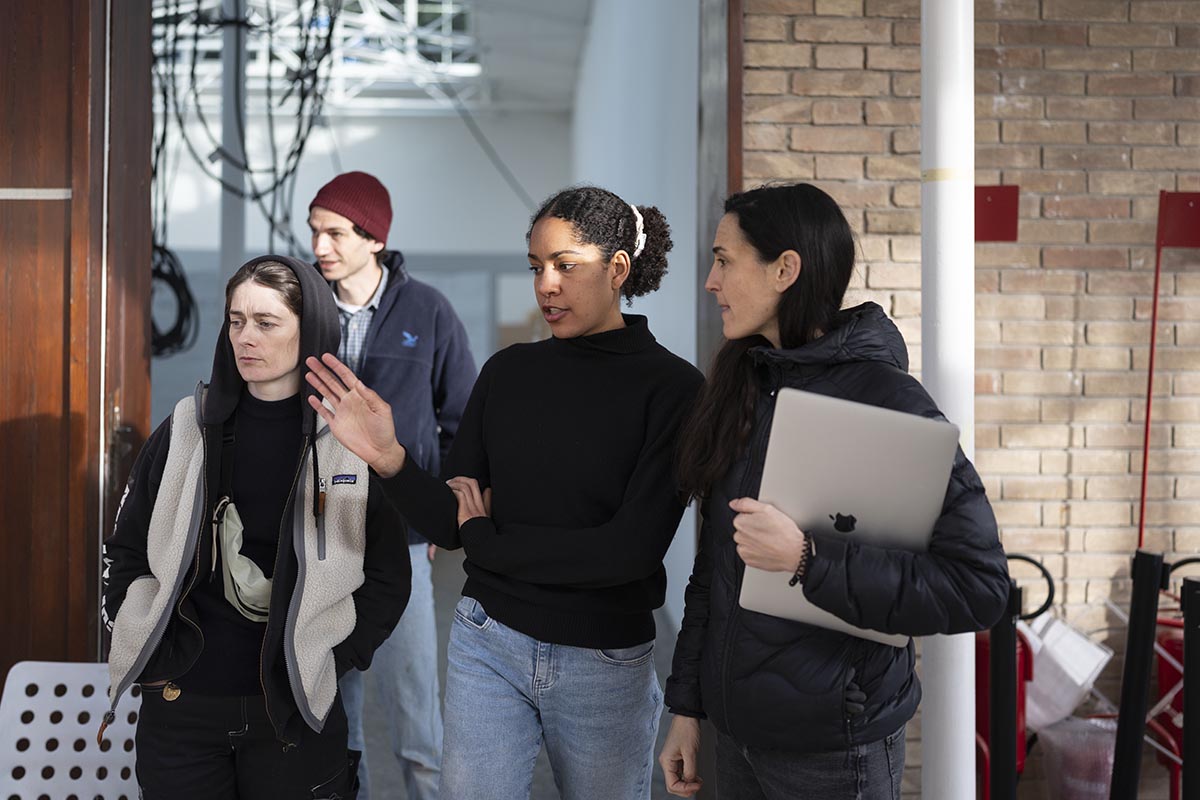
Pavilion of Switzerland at the 19th International Architecture Exhibition - La Biennale di Venezia. Curator Elena Chiavi at the construction site of the exhibition "Endgültige Form wird von der Architektin am Bau bestimmt." Image © Keystone/Gaëtan Bally
Connecting past to the present: Traces and Records of lived spaces
Visitors are encouraged to listen as they move around the area by field recordings that document encounters, conversations, landscapes, and construction activities. By revealing hidden histories and enabling the audience to interact closely and profoundly with the architectural environment, sound becomes a vehicle of translation and immersion.
In addition to bridging disparate actors, the installation's non-linearity enables a perception of architecture that goes beyond its function as a simple spatial framework to become a resonating body that is alive with sound.

Pavilion of Switzerland at the 19th International Architecture Exhibition - La Biennale di Venezia. Construction site of the exhibition "Endgültige Form wird von der Architektin am Bau bestimmt." curated by Elena Chiavi, Kathrin Füglister, Amy Perkins, Axelle Stiefel and Myriam Uzor. Image © Keystone/Gaëtan Bally
"Through the sounds, memories, and stories embedded in the exhibition, the Swiss Pavilion transforms into a place of shared agency, cultivating a vision of architecture as a vessel for collective memory," they elaborated.
"This auditory experience reveals a vibrant dimension of architecture and landscape, one that is felt and lived rather than solely observed, turning each listener into an active participant of the exhibition."
"The unfinished—or rather: the open-ended—is the realm of the poetic, where conventional ways of thinking are suspended, and a new space is imagined," they added.

Kunsthalle at the Saffa in Zurich, 1958, designed by Lisbeth Sachs. Image courtesy of gta Archiv / ETH Zürich (Lisbeth Sachs)
A group of female architects, Elena Chiavi, Kathrin Füglister, Amy Perkins, and Myriam Uzor, appreciate and emphasize a construction ethic that begins with what is currently available.
The group starts a conversation with—and learns from—those who have gone before us by using fiction as a method to bring the work of trailblazing women designers to life. The connected nature of Annexe's work links material resources to immaterial knowledge and the past to the present.
The group provides a platform for embracing feminist building approaches and collaborative forms. "Endgültige Form wird von der Architektin am Bau bestimmt" is their project. Axelle Stiefel, an embedded artist, is collaborating with the group.

Kunsthalle at the Saffa in Zurich, 1958, designed by Lisbeth Sachs. Image courtesy of gta Archiv / ETH Zürich (Lisbeth Sachs)
The 2025 Venice Architecture Biennale will take place from May 10 to November 23 November 2025 at the Giardini, the Arsenale and various venues in Venice, Italy.
Besides Swiss's contribution, other contributions at the Venice Architecture Biennale include Iceland's exhibition Lavaforming, Estonia's Let Me Warm You exhibition, the Romanian Pavilion's "Human Scale" exhibition, the Luxembourg Pavilion's Sonic Investigations exhibition, the Albanian Pavilion's "Building Architecture Culture" exhibition, the Turkey Pavilion's "Grounded" exhibition, the Pavilion of the United Arab Emirates's "Pressure Cooker" exhibition, the Finland Pavilion's "The Pavilion – Architecture of Stewardship" exhibition.
Find out all exhibition news on WAC's Venice Architecture Biennale page.
Exhibition facts
Commissioner: Swiss Arts Council Pro Helvetia: Sandi Paucic, Rachele Giudici Legittimo
Curators: Elena Chiavi, Kathrin Füglister, Amy Perkins, Axelle Stiefel, Myriam Uzor
Curators: Elena Chiavi, Kathrin Füglister, Amy Perkins, Axelle Stiefel and Myriam Uzor
Project team: For their project ‘Endgültige Form wird von der Architektin am Bau bestimmt.’ Annexe - Elena Chiavi, Kathrin Füglister, Amy Perkins, and Myriam Uzor - is working with the embedded artist Axelle Stiefel. The wider team consists of Tobias Becker (Project Coordinator), Ella Eßlinger (Grant Writer), Emma Kouassi (Graphic Design), Octave Magescas (Sound Design) and Leopold Strobl (Supporting Architect).
Exhibition dates: 10 May–23 November 2025
Pre-Opening: 8–9 May 2025
Official opening: Thursday, 8 May 2025 at 2pm
Venue: Swiss Pavilion, Giardini della Biennale di Venezia
The top image in the article: Pavilion of Switzerland at the 19th International Architecture Exhibition - La Biennale di Venezia. Construction site of the exhibition "Endgültige Form wird von der Architektin am Bau bestimmt." curated by Elena Chiavi, Kathrin Füglister, Amy Perkins, Axelle Stiefel and Myriam Uzor. Image © Keystone/Gaëtan Bally.
> via prohelvetia
exhibition pavilion Swiss Pavilion Venice Architecture Biennale
